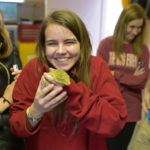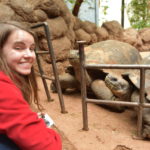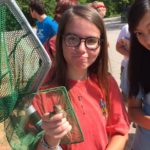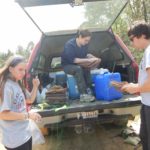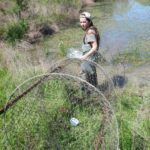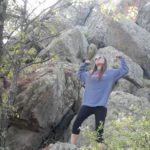Featuring our Graduating Seniors: Rachel Flanagan
-
This is the first in a series featuring the recent OU graduates who are members of the Siler Lab. In their own words, they will highlight the experiences they had with us as students, volunteers and/or employees. The second featurette is available here.
I started volunteering in the herpetology department at the Sam Noble Museum of Natural History during my junior year at OU in the fall of 2013. So far I have helped in research projects, and even had a project of my own at the museum with the help of the herpetology staff who have guided me my last two years at the university. I am extremely happy and thankful for the day that Cam and Jessa happened to come to my Evolution class that fall semester to ask for volunteers. If it were not for them, I probably would not have any idea of what I wanted to do in the future. The knowledge and skills I have acquired while working with the department are priceless.
My tasks when I first started volunteering involved putting new labels in jars and tying new tags on specimens from the collection. This may not seem like such an arduous task, but learning my way around the collection is a skill that I am proud to have. Especially since I was not familiar with the scientific names of any amphibians or reptiles when I first started volunteering. I did not have any real interest in herpetology at that point. I just wanted to volunteer in an area that had to do with any kind of animal research, so being able to examine different species of herps was invaluable to me as my interest started to grow.
My new interest into herpetology grew even more when I took a Field Herpetology class with Geoff Carpenter at the OU Biological Station. While I was there I also got to share some of my museum studies skills with the class. I took a liver sample from a road kill rat snake with the help of my friend Kayleigh Stumpf. I also got to show them how to preserve the dead specimens we had by injecting them with formalin and positioning them in the right way, then storing them in ethanol to go back to the museum.
During the fall 2014 semester, I started on my very own research project. I began swabbing for the prevalence of Batrachochytrium dendrobatidis (Bd) in museum specimens from wildlife management areas (WMAs) in Oklahoma. While researching with the museum, I learned that Bd is a fungus that digs into the skin of amphibians and causes the infectious disease chytridiomycosis. During that semester, I was also taking a class concerning the effects of global climate change where we did talk about chytrid and how it had been a leading factor in the decrease of amphibian populations. I have always been interested in disease, so working on a project of this sort was very exciting for me, and I wanted to learn more about how long the disease had been spreading in OK and in which areas. I swabbed over 600 frogs during the semester, so I became even more familiar with the collection itself. I also learned how and where to swab on the animal to get the best results and how to store the swabs in the microcentrifuge tubes with ethanol. I also learned later on, how to extract DNA from my swabs, which could be very valuable to me in my future endeavors. Jessa had me swabbing from WMAs because the department was awarded a grant from both the Oklahoma Department of Wildlife (ODWC), and the Oklahoma Zoo (CAN) to collect and swab amphibians for infectious disease from WMAs. From that grant, we could compare the prevalence of Bd in the museum specimens that I had swabbed; to the living specimens we would be collecting. I am presenting this research at the annual SSAR meeting in Lawrence, KS.
The spring of 2015 was by far the most exciting for me at the museum. I started taking another herpetology class with Cam, which was by far one of the best classes I have ever taken at OU. We also started going on weekend research trips to the southeast part of Oklahoma for the ODWC grant! I used to go on camping trips when I was younger, but going on these research excursions was amazing. We would get to our campsite during the day and set up our tents, then we would go search out possible surveying sites, a nice pond or swampy area. We would mark the area then come back at night to set traps. We would set minnow traps with dog food in the pocket to hopefully attract salamanders and tadpoles, and then we would set big turtle traps with sardines in them to attract pond turtles. Night was also the best time to look for frogs and snakes. Since it was cooler out, the frogs were slower and easier to catch, and it was easier to see them with headlamps on because you could see their eye shine. All in all, these were the best field experiences I have acquired so far. I loved working with my mentors and my colleagues during those trips and learning about the different OK fauna around the state. When we brought the live specimens back to the museum, we would first take down all possible data. We would then kill them as humanely and as fast as possible. Then we would take tissue, usually liver, then set them with formalin. Killing the animals was definitely not my favorite part, but Cam taught us how to do it in the most humane way so that the animal would not suffer long.
Working with Herpetology department all these years has made me figure out what I really love to do, and that is fieldwork. I love to be outside, and I love to be able to discover different animals in all kinds of ecosystems. If it had not been for my field experience with them, I might not have realized that that is what I really like to do. I want to research conservation, and try to do my best to slow down the decrease in biodiversity going on across the world. I know that these skills that I have learned from the museum will help me with these goals. I will be forever thankful to my mentors/friends, Dr. Cameron Siler, Jessa Watters, and all my other colleagues that I have met through the museum. You guys rock, herpers for life!
This August, Rachel will become an intern in Costa Rica at the Caño Palma Biological Station. Rachel has started her own blog to catalog her internship.
- Visiting the Oklahoma City Zoo with the Spring 2015 Herpetology course.
- Visiting the Oklahoma City Zoo with the Spring 2015 Herpetology course.
- Catching collared lizards at Lake Thunderbird with the Spring 2015 Herpetology course.
- Rachel (left) in the field in SE Oklahoma with two other graduating seniors, Dylan Lindauer (center) and Matt DeRuyter (right)
- Checking for turtles in SE Oklahoma.
- Bouldering Atoka Co., OK

